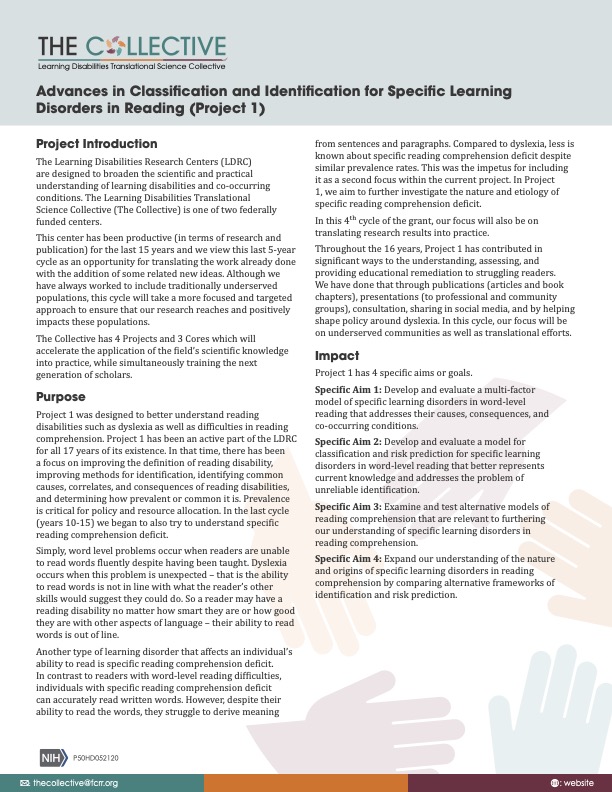Leads: Rick Wagner, Mercedes Spencer

Project Introduction
The Learning Disabilities Research Centers (LDRC) are designed to broaden the scientific and practical understanding of learning disabilities and co-occurring conditions. The Learning Disabilities Translational Science Collective (The Collective) is one of two federally funded centers.
This center has been productive (in terms of research and publication) for the last 15 years and we view this last 5-year cycle as an opportunity for translating the work already done with the addition of some related new ideas. Although we have always worked to include traditionally underserved populations, this cycle will take a more focused and targeted approach to ensure that our research reaches and positively impacts these populations.
The Collective has 4 Projects and 3 Cores which will accelerate the application of the field’s scientific knowledge into practice, while simultaneously training the next generation of scholars.
Purpose
Project 1 was designed to better understand reading disabilities such as dyslexia as well as difficulties in reading comprehension. Project 1 has been an active part of the LDRC for all 17 years of its existence. In that time, there has been a focus on improving the definition of reading disability, improving methods for identification, identifying common causes, correlates, and consequences of reading disabilities, and determining how prevalent or common it is. Prevalence is critical for policy and resource allocation. In the last cycle (years 10-15) we began to also try to understand specific reading comprehension deficit.
Simply, word level problems occur when readers are unable to read words fluently despite having been taught. Dyslexia occurs when this problem is unexpected – that is the ability to read words is not in line with what the reader’s other skills would suggest they could do. So a reader may have a reading disability no matter how smart they are or how good they are with other aspects of language - their ability to read words is out of line.
Another type of learning disorder that affects an individual’s ability to read is specific reading comprehension deficit. In contrast to readers with word-level reading difficulties, individuals with specific reading comprehension deficit can accurately read written words. However, despite their ability to read the words, they struggle to derive meaning from sentences and paragraphs. Compared to dyslexia, less is known about specific reading comprehension deficit despite similar prevalence rates. This was the impetus for including it as a second focus within the current project. In Project 1, we aim to further investigate the nature and etiology of specific reading comprehension deficit.
In this 4th cycle of the grant, our focus will also be on translating research results into practice. Throughout the 16 years, Project 1 has contributed in significant ways to the understanding, assessing, and providing educational remediation to struggling readers. We have done that through publications (articles and book chapters), presentations (to professional and community groups), consultation, sharing in social media, and by helping shape policy around dyslexia. In this cycle, our focus will be on underserved communities as well as translational efforts.
Impact
Project 1 has 4 specific aims or goals.
Aim 1
Develop and evaluate a multi-factor model of specific learning disorders in word-level reading that addresses their causes, consequences, and co-occurring conditions.
Aim 2
Develop and evaluate a model for classification and risk prediction for specific learning disorders in word-level reading that better represents current knowledge and addresses the problem of unreliable identification.
Aim 3
Examine and test alternative models of reading comprehension that are relevant to furthering our understanding of specific learning disorders in reading comprehension.
Aim 4
Expand our understanding of the nature and origins of specific learning disorders in reading comprehension by comparing alternative frameworks of identification and risk prediction.


